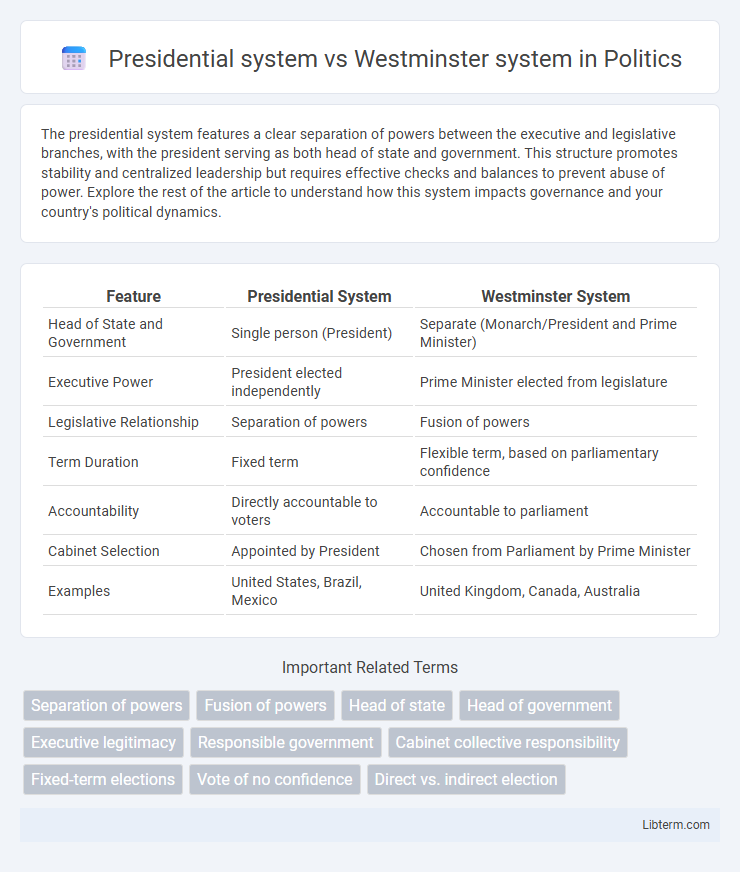The presidential system features a clear separation of powers between the executive and legislative branches, with the president serving as both head of state and government. This structure promotes stability and centralized leadership but requires effective checks and balances to prevent abuse of power. Explore the rest of the article to understand how this system impacts governance and your country's political dynamics.
Table of Comparison
| Feature | Presidential System | Westminster System |
|---|---|---|
| Head of State and Government | Single person (President) | Separate (Monarch/President and Prime Minister) |
| Executive Power | President elected independently | Prime Minister elected from legislature |
| Legislative Relationship | Separation of powers | Fusion of powers |
| Term Duration | Fixed term | Flexible term, based on parliamentary confidence |
| Accountability | Directly accountable to voters | Accountable to parliament |
| Cabinet Selection | Appointed by President | Chosen from Parliament by Prime Minister |
| Examples | United States, Brazil, Mexico | United Kingdom, Canada, Australia |
Introduction to Presidential and Westminster Systems
The Presidential system features a clear separation of powers with an independently elected president serving as both head of state and government, ensuring distinct executive authority. The Westminster system, rooted in parliamentary democracy, merges the executive and legislative branches, where the prime minister is drawn from the majority party in the legislature. Both systems shape governance dynamics significantly, influencing political stability and accountability across countries.
Key Features of the Presidential System
The Presidential system features a distinct separation of powers where the President serves as both head of state and government, elected independently of the legislature. This system emphasizes a fixed term for executive office, direct voter mandate, and a robust system of checks and balances between branches. The President holds significant authority over the executive branch, including appointment powers and veto capabilities, ensuring a centralized yet accountable leadership structure.
Core Characteristics of the Westminster System
The Westminster system is characterized by a parliamentary democracy where the executive branch derives legitimacy from and is accountable to the legislature, typically led by a Prime Minister who is a member of the elected parliament. This system features a fusion of powers rather than strict separation, with the head of government and cabinet responsible to the elected House of Commons, facilitating collective ministerial responsibility. Key elements include a constitutional monarchy or a ceremonial president as head of state, an oppositional party acting as a government-in-waiting, and regular, free elections to maintain government accountability.
Separation of Powers: Presidential vs Westminster
The Presidential system features a clear separation of powers among the executive, legislative, and judicial branches, ensuring that the president operates independently from the legislature. In contrast, the Westminster system integrates the executive and legislative branches, where the prime minister and the cabinet are drawn from the parliament, leading to a fusion rather than separation of powers. This structural difference affects accountability mechanisms and the balance of power within a government.
Role of Executive and Legislature in Both Systems
The presidential system features a clear separation of powers where the executive, led by the president, operates independently from the legislature, which holds law-making authority with distinct checks on presidential power. In contrast, the Westminster system merges executive and legislative roles by vesting executive authority in the prime minister and cabinet, drawn from the majority party or coalition in the legislature, ensuring executive accountability to the legislative body. This fusion in Westminster enables efficient policy implementation but limits the legislature's independence compared to the presidential system's rigid institutional separation.
Election Process and Term Limits
The Presidential system features a direct election process where citizens vote individually for the president, who usually serves a fixed term with strict limits to prevent extended rule. In contrast, the Westminster system relies on parliamentary elections where the prime minister is typically the leader of the majority party and can remain in office as long as they maintain parliamentary confidence without formal term limits. The fixed terms and direct election in the Presidential system emphasize separation of powers, whereas the Westminster system's flexible tenure fosters closer executive-legislative integration.
Accountability and Checks and Balances
The Presidential system features a clear separation of powers, enabling direct accountability as the executive branch is independently elected and can be held responsible by voters through fixed terms. The Westminster system integrates executive and legislative branches, fostering collective accountability where the Prime Minister and cabinet are accountable to the parliament and can be removed by a vote of no confidence. Checks and balances in the Presidential system rely on institutional separation, while the Westminster system depends on parliamentary oversight and party discipline to maintain government accountability.
Advantages of Presidential and Westminster Systems
The Presidential system offers clear separation of powers, enabling direct accountability of the executive to voters and preventing undue legislative interference. The Westminster system promotes strong party discipline and efficient law-making through its fusion of executive and legislative functions, allowing swift policy implementation. Both systems enhance democratic governance by balancing stability with responsiveness tailored to different political contexts.
Criticisms and Challenges
The Presidential system often faces criticism for potential gridlock due to the separation of powers, where the executive and legislature may clash, hindering efficient governance. The Westminster system encounters challenges such as excessive concentration of power in the Prime Minister's office, risking authoritarian tendencies and undermining checks and balances. Both systems struggle with accountability issues, but the fixed terms in Presidential systems can lead to prolonged periods of ineffective leadership, whereas the Westminster system allows for more flexible parliamentary dissolutions.
Conclusion: Choosing the Right System
Selecting the appropriate governance model depends on a country's historical context, political culture, and institutional needs. The presidential system offers clear separation of powers and executive stability, while the Westminster system promotes stronger legislative control and flexibility in government formation. Effective governance arises from aligning the system with national priorities, ensuring accountability, and fostering democratic values tailored to the society's unique dynamics.
Presidential system Infographic

 libterm.com
libterm.com